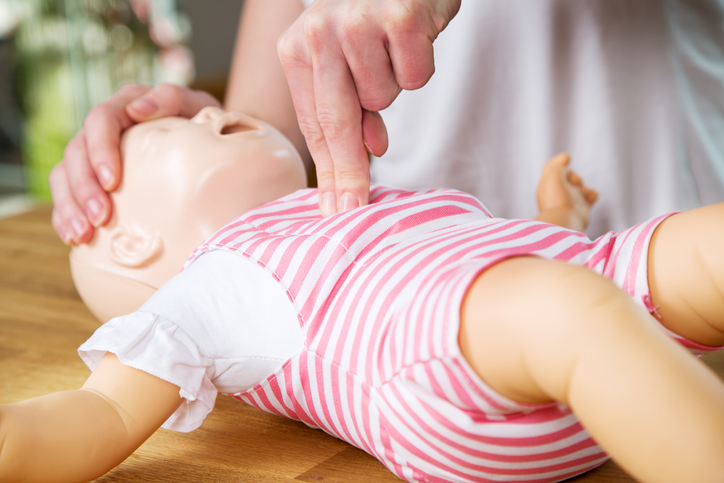Having the knowledge and confidence to administer infant CPR and first aid can be the difference between life and death for your child. As a parent, being able to understand infant CPR, check responsiveness, identify proper chest compressions and ventilation, and more allows you to protect your child.

Conscious and unconscious choking incidents are very common among infants. Learning the Heimlich maneuver can effectively dislodge obstructions from your child and restore their airway. Parents should also be well-versed in handling and treating burns and scalds as well as recognizing signs of dehydration or fever.
It is also important to be aware of allergic reactions and anaphylaxis which can escalate rapidly. Knowing the symptoms and how to use an epinephrine auto-injector correctly is important. Seizures or head injury are special situations that require particular attention and parental preparation. Lastly, recognizing signs of heatstroke and responding promptly to heat-related issues is crucial, especially in hot weather conditions. By being well-informed and proactive, parents can respond effectively to poisoning incidents or instances of ingestion, ensuring the safety of their infants.
Understanding Infant CPR
Infant CPR, or cardiopulmonary resuscitation, is a life-saving technique designed to revive an unresponsive infant whose breathing or heartbeat has stopped. It is an important skill for parents to learn as it can be the difference between life and death in emergencies such as sudden cardiac arrest or respiratory failure. By knowing how to perform infant CPR, parents can take immediate action while waiting for professional medical help to arrive.
A step-by-step guide to infant CPR starts with assessing the infant’s responsiveness by gently tapping and shouting to check for any signs of movement or response. If the infant is unresponsive, the first step is to call for emergency medical help immediately. Next, the parent should carefully position the infant on a firm, flat surface and open the airway by gently tilting the head and lifting the chin. Compressions and ventilations are then alternated, with the proper compression-to-ventilation ratio for infants being 30 compressions to 2 breaths. It is essential to ensure the hand placement is correct when administering chest compressions – two fingers in the center of the chest just below the nipple line.
Using an infant-sized CPR mask or barrier device is significant in these situations as it provides a barrier between the parent and the infant’s mouth, reducing the risk of infection transmission. These masks or devices are designed specifically for infants and should be readily available in first aid kits. The cost of an infant-sized CPR mask or barrier device typically ranges from $5 to $15, making it an affordable and essential investment for parents.
Understanding the ins and outs of infant CPR allows parents to be more prepared to handle emergencies effectively and respond swiftly and decisively during critical situations, potentially saving their infant’s life.
Handling Choking Emergencies
Common signs of choking include difficulty breathing, coughing, gagging, or wheezing. The infant may also display a bluish discoloration of the lips or skin, indicating a lack of oxygen. If an infant is conscious and choking, parents should encourage them to cough forcefully, as this may dislodge the obstruction. Stay calm, and closely monitor the infant while being prepared to act if the situation worsens.
Take immediate action to restore your infant’s airway if and when they become unconscious due to choking. Begin by placing the infant on a firm, flat surface and ensuring the airway is open. If the obstruction is visible and accessible, attempt to remove it using your fingers, but avoid blindly sweeping the mouth. If the obstruction remains and the infant is unresponsive, call for emergency medical help immediately. Then, begin infant CPR, combining chest compressions and gentle breaths to attempt to dislodge the object. Continue these life-saving measures until professional help arrives.
Performing the Heimlich maneuver on a choking infant safely is an important skill to have. To execute this technique, assume a seated or kneeling position and position the infant face down on your forearm, supporting their head and jaw with your hand. Deliver five firm back blows between the infant’s shoulder blades using the heel of your hand. If the obstruction persists, turn the infant face up, place two fingers on their breast bone just below the nipple line, and deliver five quick chest thrusts. Alternate between back blows and chest thrusts until the object is dislodged or professional medical assistance arrives.
Infants are naturally curious and may put objects in their mouths so being prepared to handle choking emergencies is highly important. It is worth investing in a reputable infant CPR and first aid training course in order to respond promptly and effectively during critical moments. The cost of certified CPR and first aid training typically ranges from $50 to $100, providing parents with invaluable skills that could save their infant’s life in an emergency.
First Aid for Common Injuries and Illnesses in Infants
Accidents happen, so having knowledge of basic first aid practices such as treating burns and scalds, managing a fever and understanding its potential dangers, treating insects bites and stings, and properly caring for minor cuts and wounds for your infant is very important in ensuring their safety.
First Aid for Burns and Scalds
Accidents involving burns and scalds can happen typically in the presence of hot liquids, steam, or hot surfaces. When dealing with such injuries in infants, start by removing the infant from the source of the burn or scald and quickly cool the affected area under cool running water for at least 10 minutes. Avoid using ice or very cold water as it can further damage the delicate skin. After cooling the burn, gently pat the area dry with a clean cloth and cover it with a sterile, non-stick dressing or cling film to protect it from infection. Seek medical attention if the burn is severe, covers a large area, or if it affects the face, hands, feet, or genitals.
Managing Fever in Infants and Potential Dangers
Fever is a common indication of an underlying illness in infants. The first step is to check the infant’s temperature using a reliable thermometer. If the temperature reads 100.4°F (38°C) or higher, the infant has a fever. To bring down the fever, dress the baby in light clothing, keep the room at a comfortable temperature, and offer fluids to prevent dehydration. Never give aspirin to an infant, as it is associated with a serious condition called Reye’s syndrome. For infants under three months old with a fever, seek medical attention promptly, as their immune systems are still developing and they may be at higher risk for serious infections.
First Aid for Insect Bites or Stings
Insect bites or stings can cause discomfort and irritation in infants. To provide first aid, start by washing the affected area gently with soap and water to reduce the risk of infection. Use a cold compress or ice pack wrapped in a cloth to reduce swelling and soothe the area. Avoid scratching the bite or sting to prevent further irritation and the risk of infection. If the bite or sting appears to be causing an allergic reaction, such as severe swelling, difficulty breathing, or hives, seek immediate medical attention.
Minor Cuts and Wounds
Minor cuts and wounds can happen anytime. To handle them, begin by cleaning the wound with mild soap and water, gently removing any dirt or debris. Pat the area dry with a clean cloth and apply an over-the-counter antibiotic ointment to prevent infection. Cover the wound with a sterile adhesive bandage or gauze pad and secure it in place with medical tape. Change the dressing daily and monitor the wound for any signs of infection, such as increasing redness, swelling, or pus. Seek medical attention for deep or large wounds, wounds that won’t stop bleeding, or if there is concern about infection.
To be properly equipped to address first aid issues, have a well-stocked first aid kit at home, which may include bandages, gauze pads, adhesive tape, scissors, antiseptic wipes, a thermometer, and an instant cold pack. The cost of a basic first aid kit typically ranges from $15 to $30, and it can be a valuable investment in ensuring your infant’s safety and well-being.
Addressing Allergic Reactions
Allergic reactions should be taken seriously. Being able to identify common allergic reactions, the warning signs of anaphylaxis, and knowing how to respond allows for parents to effectively and instantly help their infant.
Common Allergic Reactions in Infants and Their Management
Allergic reactions in infants can manifest in various ways, and it’s important for parents to recognize the signs and take appropriate action. Common allergic reactions may include hives (red, raised, itchy bumps on the skin), facial swelling, itching, and redness around the eyes or mouth. In more severe cases, an allergic reaction can lead to difficulty breathing, wheezing, coughing, or vomiting. If an infant exhibits any of these symptoms after exposure to a potential allergen, it is essential to remove the trigger and seek medical attention promptly. An over-the-counter antihistamine may help alleviate mild symptoms, but it’s crucial to consult with a healthcare professional before administering any medication to an infant.
Warning Signs of Anaphylaxis and How to Respond
Anaphylaxis is a severe and potentially life-threatening allergic reaction that requires immediate medical attention. The warning signs parents should be aware of include difficulty breathing, swelling of the face and throat, rapid or weak pulse, and a drop in blood pressure. An infant experiencing anaphylaxis may become pale or blue and may appear weak or confused. If anaphylaxis is suspected, do not hesitate to call emergency services and administer an epinephrine auto-injector if one has been prescribed for the infant’s known allergies. The epinephrine auto-injector, commonly known as an EpiPen, delivers a dose of epinephrine that can reverse the effects of the severe allergic reaction. After administering epinephrine, seek immediate medical attention even if the symptoms seem to improve, as a second dose may be needed in some cases.
Parents of infants with known allergies should always have an anaphylaxis action plan provided by their healthcare provider. This plan outlines specific steps to take in case of an allergic reaction, including the proper use of the epinephrine auto-injector. Regular communication with the child’s healthcare provider is essential to ensure that the action plan is up-to-date and tailored to the infant’s specific needs. Being vigilant about allergen avoidance and prepared to respond to allergic reactions promptly can help parents safeguard their infants’ health and well-being.
Dealing with Special Situations
Special situations including infant seizures, head injuries, and sudden loss of consciousness can occur. It is important for parents to understand what to do and how to respond in order to protect their children and get them the assistance they need.
What to Do and What Not to Do in Infant Seizures
Parents must stay calm and take immediate action when witnessing an infant having a seizure. During a seizure, lay the infant on their side on a flat surface to prevent choking on saliva or vomit. Avoid restraining or holding the infant down, as it could cause injury. Time the duration of the seizure, as this information is crucial for medical professionals. After the seizure ends, gently comfort the infant and keep them in a safe and quiet environment. It is essential to seek medical attention if it is the infant’s first seizure, if the seizure lasts longer than five minutes, or if additional seizures follow without the infant regaining consciousness between them.
Addressing Head Injuries in Infants and When to Seek Medical Attention
Head injuries in infants can occur from falls, accidents, or any impact to the head. Even seemingly minor bumps can be concerning, and parents should closely monitor the infant for any signs of a more serious injury. After a head injury, observe the infant for symptoms such as persistent crying, vomiting, loss of balance, changes in behavior, or excessive drowsiness. If any of these symptoms are present or if the injury resulted from a significant impact, seek immediate medical attention. Depending on the severity of the head injury, medical professionals may conduct further evaluations, such as a head CT scan, to ensure there is no internal damage.
Sudden Loss of Consciousness in Infants and Actions to Take
If an infant suddenly loses consciousness, the first step is to check for responsiveness. Tap the infant gently and speak to them loudly to elicit a response. If there is no response, call emergency services immediately. While waiting for help to arrive, place the infant on their back on a firm, flat surface and begin infant CPR if there is no breathing or pulse. If there is a pulse but the infant is not breathing, provide rescue breaths until professional medical help arrives. Identifying and responding promptly to the sudden loss of consciousness can significantly impact the outcome in these critical situations.
Being prepared to handle special situations such as seizures, head injuries, and sudden loss of consciousness empowers parents to act confidently and effectively during emergencies. The swift and appropriate response can make a significant difference in the well-being and recovery of the infant. Staying informed about first aid techniques and knowing when to seek medical attention is important for ensuring the best possible outcome in these challenging situations.
Poisoning and Ingestion
It is important to know how to react as a parent if your infant consumes something potentially harmful or is having a reaction to common medicine. Therefore, having knowledge of potential poisoning incidents and understanding how to respond to allergic reactions to vaccines are essential aspects when it comes to your infant’s safety.
Steps to Take If an Infant Ingests a Harmful Substance or Medication
Accidental ingestion of harmful substances or medications is a serious concern for parents of infants. If an infant ingests something potentially toxic, the first step is to remain calm and not panic. Immediately remove the harmful item from the infant’s mouth if it is safe to do so, but avoid causing any harm inadvertently. It is crucial to never try to induce vomiting in an infant unless specifically instructed to do so by a healthcare professional. Instead, seek immediate medical attention by calling your local poison control center or emergency services. Be prepared to provide essential information, such as the substance ingested, the quantity, and the infant’s age and weight. While waiting for medical help to arrive, keep the infant comfortable and closely monitor their breathing and consciousness level.
Recognizing Symptoms of a Possible Allergic Reaction to Vaccines and What to Do
Vaccines are important for protecting infants from various serious diseases, but some infants may experience mild reactions as their immune system responds to the immunization. Common side effects can include redness or soreness at the injection site, mild fever, and fussiness. However, in rare cases, an allergic reaction may occur. Signs of an allergic reaction to vaccines may include difficulty breathing, facial swelling, hives, or a fast-beating heart. If any of these symptoms appear after vaccination, it is essential to seek immediate medical attention. Healthcare providers are trained to manage vaccine reactions, and they can evaluate the severity of the reaction and provide appropriate treatment. Most vaccine-related reactions are mild and resolve on their own, but it is crucial for parents to be vigilant and communicate any concerns with their healthcare provider.
Having the contact information for your local poison control center and knowing the steps to take in emergencies can help parents act swiftly and appropriately. For infants receiving vaccinations, stay informed about common side effects and be prepared to seek medical attention if any concerning symptoms arise.
Handling Dehydration and Heatstroke
Being aware of the signs of dehydration and heatstroke in infants is crucial for parents to protect their children during hot weather or illness.
Signs of Dehydration in Infants and How to Manage It
Dehydration in infants occurs especially during hot weather or when they are experiencing an illness with fever, vomiting, or diarrhea and timely action must be taken. Common signs of dehydration in infants include a dry mouth and tongue, decreased urine output or dark-colored urine, sunken eyes, and lethargy or irritability. If you suspect your infant is dehydrated, it’s essential to offer them small, frequent sips of an oral rehydration solution (ORS). Commercially available ORS products like Pedialyte are designed to replace lost fluids and electrolytes and can be found at most drugstores or supermarkets. Alternatively, you can make a homemade ORS by mixing one liter of clean water with six teaspoons of sugar and half a teaspoon of salt. Always consult with a healthcare professional if you suspect your infant is dehydrated, as they can provide personalized advice based on the infant’s condition and medical history.
Symptoms of Heatstroke in Infants and Appropriate Responses
Heatstroke is a severe condition that can occur when an infant’s body temperature rises dangerously high due to prolonged exposure to hot temperatures. Infants are particularly vulnerable to heatstroke as their bodies have not yet fully developed the ability to regulate temperature effectively. Symptoms of heat stroke may include a high body temperature (above 103°F or 39.4°C), hot and dry skin, rapid breathing, and lethargy or unconsciousness. If you suspect your infant is experiencing heat stroke, it is essential to act quickly to cool them down. Move the infant to a shaded or air-conditioned area, remove any excess clothing, and use cool water or damp cloths to gently lower their body temperature. Do not use ice-cold water or immerse the infant in cold water, as this can cause shock. Seek immediate medical attention if the infant’s condition does not improve or if they appear to be in distress.
Preventive measures such as keeping infants well-hydrated and ensuring they are in a cool and shaded environment helps prevent these conditions from occurring. In case of dehydration or heat stroke, prompt and appropriate responses can make a significant difference. Remember that infants are more susceptible to these conditions, so it’s essential to closely monitor their behavior and take any concerning symptoms seriously.
The Importance of First Aid in Anaphylaxis
The timely use of an epinephrine auto-injector can save an infant’s life during an anaphylactic reaction. Understanding the signs of anaphylaxis and having the knowledge to administer epinephrine promptly empowers parents to take swift action in these situations.
Anaphylaxis is a severe and potentially life-threatening allergic reaction that requires immediate medical attention. For parents of infants with known allergies, being prepared to administer first aid in the event of an anaphylactic reaction is of utmost importance. Anaphylaxis can occur rapidly and escalate quickly, leading to difficulty breathing, a drop in blood pressure, and loss of consciousness. The prompt administration of epinephrine is crucial in managing anaphylaxis and reversing its effects.
Properly Using an Epinephrine Auto-Injector for Infants
An epinephrine auto-injector, commonly known as an EpiPen, is a life-saving device that delivers a precise dose of epinephrine to counteract the severe allergic reaction. Parents of infants with severe allergies should always carry an EpiPen with them and ensure that family members, caregivers, and those frequently in contact with the infant know how to use it correctly. To use the EpiPen, remove the safety cap, hold it firmly against the infant’s outer thigh, and push down firmly to activate the injection. The injection should be held for a few seconds before removing the EpiPen from the thigh. Following the administration of epinephrine, it is essential to seek immediate medical attention, even if the infant’s symptoms seem to improve, as further treatment may be necessary.
Regular communication with the infant’s healthcare provider and having an up-to-date anaphylaxis action plan should be implemented to ensure that parents are well-prepared and confident in managing anaphylactic reactions. Remember, early intervention and proper first aid are key to ensuring the best possible outcome for infants experiencing severe allergic reactions.
Take Away
Learning infant CPR and first aid is crucial for parents to respond effectively in emergencies involving their infants. From CPR techniques to addressing choking incidents, common injuries, and allergic reactions, these skills can potentially save their infant’s life. Enrolling in certified first aid courses and regular practice empower parents to create a safer environment for their infants and provide immediate care when it matters most.




